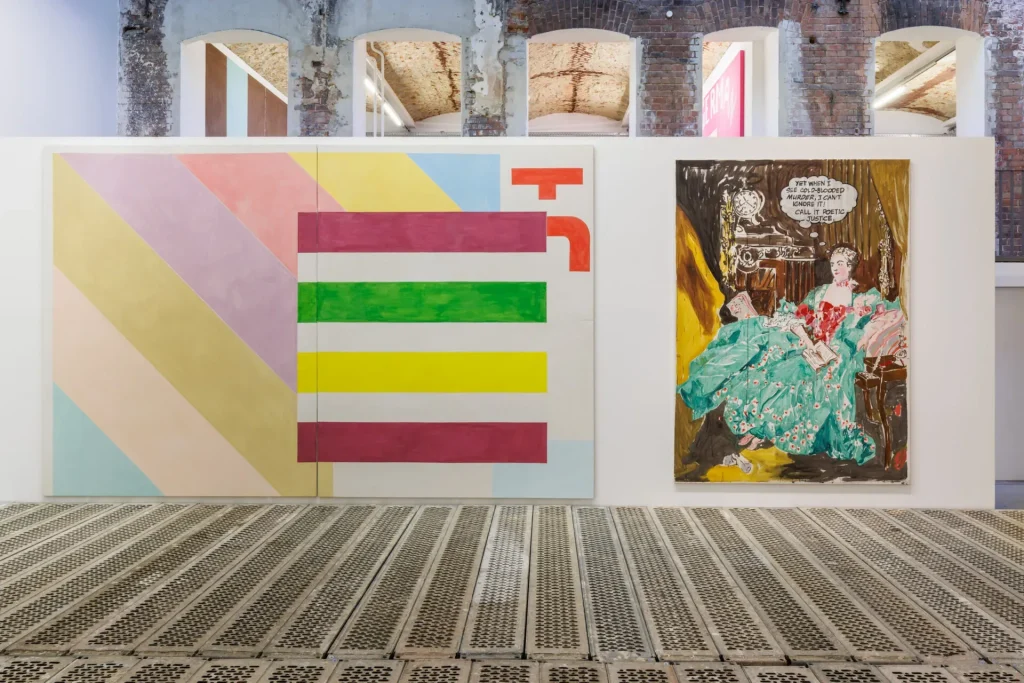Michel Majerus was a trailblazing artist known for his dynamic fusion of digital and traditional media, who tragically lost his life in a plane crash in 2002. Prior to his untimely demise, Majerus had made significant strides in the art world, showcasing his work at prestigious exhibitions such as the Venice Biennale. His innovative approach, which integrated elements like early internet aesthetics and Abstract Expressionism, has left a lasting legacy in the realm of digital art. Notably, his upgraded Apple PowerBook G3 laptop survived the accident, harboring a wealth of creative files that offer insight into his artistic process. The impact of Majerus’s work continues to influence contemporary artists, with figures like Cory Arcangel examining this digital art legacy to understand his profound influence on modern artistic expression.
Michel Majerus, a visionary painter from Luxembourg, revolutionized the intersection of art and technology through his captivating pieces blending traditional painting with digital media. His creative journey, marked by innovative installations and a keen awareness of internet culture, has ignited curiosity among art enthusiasts and historians alike. The unfortunate end of his life in 2002 only amplified interest in his artistic contributions, particularly through the investigation of his surviving Apple laptop. This device became a portal into Majerus’s creative mind, showcasing a digital archive that reflects his methodological approach and significant impact on the digital art landscape. As contemporaries like Cory Arcangel delve into Majerus’s past to unearth his influences and techniques, the dialogue around his work continues to thrive, celebrating the legacy he left behind.
The Life and Untimely Death of Michel Majerus
Michel Majerus, born in Luxembourg, emerged as a promising figure in the contemporary art scene before his tragically premature death in 2002 at the age of thirty-five. His works, known for their vibrant colors and innovative engagement with digital culture, were significantly recognized in major exhibitions, such as his solo show in Switzerland in 1996 and his impactful installation at the Venice Biennale in 1999. Majerus’s art skillfully melded traditional painting with digital influences, showcasing an artist forward-thinking in the rapidly evolving world of technology. His untimely demise in a plane crash not only cut short his burgeoning career but also left a void in the art community that could not easily be filled.
In reflecting on Majerus’s artistry, it’s essential to acknowledge the fusion he created between analog and digital media. His approach laid the groundwork for what many contemporary artists explore today, emphasizing the confluence of internet culture and traditional art forms. The loss of Majerus was felt deeply, as his ability to incorporate the early language of digital culture into his canvas inspired many, shaping the course for digital artists that followed. His legacy remains a poignant reminder of how the intersection between art and technology can yield extraordinary creativity.
Michel Majerus’s Influence on Digital Art
Michel Majerus’s influence on digital art cannot be overstated; he was a pivotal figure who predated the current boom of art heavily reliant on digital tools and themes. His work often showcased pixels and digital motifs, blending them seamlessly into his paintings. Majerus understood that the internet was not merely a tool for artists but a vibrant and dynamic canvas of its own. This foresight positioned him as a precursor to later digital artists who would emerge, including Cory Arcangel, who have continued to evolve and explore the dialogue between the digital realm and traditional mediums.
In the realm of digital art, Majerus’s legacy is reflected in how artists like Arcangel utilize modern technology to push creative boundaries. While working on Majerus’s recovered hard drive, Arcangel discovered the powerful strategies Majerus employed—using software to manipulate images before ever applying paint. This technique not only showcases his advanced understanding of technology but also reveals how he laid the groundwork for a generation of digital creators. As digital art continues to grow in importance and stature, the influence of Majerus remains a critical touchpoint.
Cory Arcangel and the Revival of Majerus’s Work
Cory Arcangel plays a crucial role in reviving and preserving Michel Majerus’s legacy through his exploration of the artist’s recovered iMac hard drive. Upon accessing the files, Arcangel discovered a treasure trove of Majerus’s digital creations, granting insight into his creative process. This included files that demonstrated how the artist zoomed in on and manipulated images from past artworks, showcasing a meticulous and innovative approach. By engaging with Majerus’s work, Arcangel aims to bridge the gap between traditional artistry and contemporary digital approaches, embodying the spirit of what Majerus represented.
Arcangel’s determination to understand and share Majerus’s methodology reflects the ongoing dialogue between different art forms and generations. His YouTube series, ‘Let’s Play Majerus G3,’ combines gameplay with art commentary, allowing audiences to engage with the artistic process in an interactive way. By presenting Majerus’s digital practices through a modern lens, Arcangel not only pays homage to the artist’s contributions but also challenges viewers to reconsider the boundaries between digital art and traditional painting. This fusion demonstrates how technology can breathe new life into past artistic endeavors.
The Impact of Majerus’s Digital Art Legacy
Majerus’s digital art legacy extends beyond his lifetime, serving as a guiding influence for future artists grappling with the nuances of technology in their work. The creative tension between traditional methods and the emergent possibilities of the digital landscape is keenly observed in his installations, where pixelated imagery dances alongside bold painting techniques. This juxtaposition underscores a significant moment in art history, where the norms of art were being radically redefined through digital intervention. The works that emerged from this philosophy not only engaged with the audience’s experiences of modernity but also commented on the rapid evolution of cultural consumption.
As the digital landscape continues to evolve, the relevance of Majerus’s work remains palpable. His art taps into a shared nostalgia for the early internet, perfectly capturing the essence of a transitional period influential in shaping contemporary artistic practices. The manner in which Majerus integrated technology into his creative framework has paved the way for artists today to explore, innovate, and redefine the essence of their work. His legacy will undoubtedly inspire future generations to navigate the complex interplay between art and technology.
A Deep Dive into Majerus’s Use of Technology
Michel Majerus adeptly utilized technology as both a tool and a subject of his art, cleverly intertwining it with traditional painting techniques. His preferred medium, the Apple PowerBook G3, represents an iconic moment where digital tools began influencing artistic expression significantly. Majerus’s understanding of the software allowed him to manipulate and compose images with a precision that elevated his traditional canvases into a new realm. This innovative approach is evident in his collages, where he blends elements from popular culture, video game aesthetics, and classical painting styles to create something wholly original.
The recovery of Majerus’s hard drive has provided invaluable insights into his artistic practices, revealing how he methodically constructed his artworks within digital space before transferring them to canvas. This process aligns with the contemporary trend of artists utilizing digital design for their physical pieces, showcasing a paradigm shift that Majerus was ahead of during his time. By examining this unique intersection of technology and art, viewers can better appreciate the technical acumen and foresight that defined Majerus’s contributions to the art world.
Preservation of Digital Art and Its Challenges
The preservation of digital art poses a significant challenge for institutions and artists alike, as many works from the early days of the internet have been lost to the ravages of obsolescence. Michel Majerus’s laptop serves as a poignant reminder of this issue. His hard drive, containing a wealth of creative materials, showcased the importance of preserving digital files to maintain the integrity of an artist’s legacy. Dragan Espenschied’s efforts at Rhizome highlight the need to not only recover lost works but also to ensure that the tech used to create these pieces is understood and appreciated. This meticulous archival process becomes essential as we navigate the ever-evolving digital landscape.
As the art world grapples with the fleeting nature of digital formats, initiatives to conserve works like Majerus’s become indispensable. By archiving his creative process and artistic output, we begin to fill critical gaps in art history, particularly in understanding how artists like Majerus and their digital counterparts have contributed to contemporary practices. This preservation work ensures that future generations can explore and engage with the intricate relationships between art and technology, thus reinforcing and celebrating the diverse narratives that shape our cultural history.
The Role of Nostalgia in Majerus’s Art
Nostalgia plays a crucial role in the understanding of Michel Majerus’s body of work, seamlessly intertwining with his exploration of modern technology. His paintings, often infused with a sense of yearning for the past, evoke memories of a time when the digital world was just beginning to unfold. This interplay between nostalgia and innovation is evident in his art, as he boldly incorporates elements from the early digital age—shapes, colors, and sounds—that resonate with viewers who experienced the internet’s infancy. This reflection on the past invites audiences into a dialog about how technology can evoke emotion and memory through artistic expression.
As we navigate the complexities of a digital world filled with ever-changing trends, Majerus’s work encourages a reconsideration of how nostalgia informs the aesthetic experience. His vibrant and chaotic compositions evoke a sense of longing while simultaneously celebrating technological advancements. By embracing nostalgia, Majerus invites viewers to connect on a deeper emotional level, prompting a reflective contemplation of their own experiences in contrast to the rapid pace of contemporary digital life. This connection underscores the timeless relevance of his art and its power to resonate across generations.
Majerus’s Artistic Methodology
Michel Majerus’s artistic methodology was distinctly characterized by the integration of technology into every aspect of his practice. He was not simply a painter but a pioneer who understood how to leverage software to enhance and dictate his artistic vision. His use of digital tools exemplified a thorough understanding of media that informed his canvases. By utilizing software like Photoshop to design his works before they reached the canvas, Majerus blurred the lines between traditional painting and digital creativity—demonstrating a holistic approach to art-making that is now commonplace among contemporary artists.
This meticulous methodology resulted in artworks that appear fresh and dynamic, showcasing a unique palette and thematic cohesion that continues to engage and influence audiences. Majerus’s ability to visualize how digital art could coexist with traditional mediums speaks to his innovative spirit and acute awareness of shifting cultural landscapes. As a forerunner in embracing digital tools, his methodology serves as a profound reference point for today’s artists navigating similar intersections between technology and creativity.
Revisiting Early Digital Culture through Majerus’s Lens
The work of Michel Majerus offers a unique lens through which to revisit and critically assess early digital culture. His art is undeniably interconnected with the digital phenomena that characterized the late 1990s and early 2000s, incorporating visual elements that resonate with audiences familiar with the aesthetics of early internet design. By amalgamating pop culture references, video game imagery, and nostalgic web design, Majerus captures the exuberance and chaos of digital life during its formative years, creating a dialogue that remains relevant in today’s hyper-connected world.
Moreover, Majerus’s visual language encourages viewers to consider the implications of technology in their lives. His work embodies the excitement and anxiety of a rapidly evolving digital landscape, prompting reflections on how art can encapsulate cultural moments. By revisiting his creations, contemporary audiences can gain insight into the foundational stages of digital art’s evolution and its implications for modern artistic practices. Just as Majerus leveraged early software to formulate his artistic voice, today’s artists continue to explore and expand the boundaries set by digital culture.
Frequently Asked Questions
What is the significance of Michel Majerus in digital art?
Michel Majerus is significant in digital art due to his innovative approach that fused painting with early digital culture influences, such as video games and internet aesthetics. His work reflects a unique juxtaposition of abstract expressionism and digital imagery, showcasing how traditional art forms can integrate with modern technology.
How did Michel Majerus use his Apple laptop in his artistic process?
Michel Majerus utilized his upgraded Apple PowerBook G3 laptop as a vital tool in his creative process. He employed Photoshop to design his paintings, experimenting with digital collages and virtually installing pieces before actual execution. This integration of digital technology allowed him to customize his art with precision.
What are the lasting influences of Michel Majerus on contemporary artists?
The lasting influence of Michel Majerus on contemporary artists can be seen in the way his work blends digital culture with traditional art forms. His use of everyday technology and internet aesthetics has inspired a generation of artists eager to explore similar intersections, making him a pivotal figure in the evolution of digital art.
How did Cory Arcangel revive Michel Majerus’s digital art legacy?
Cory Arcangel revived Michel Majerus’s digital art legacy by recovering data from Majerus’s laptop, which contained significant files and artworks. Arcangel’s efforts, including the creation of ‘Let’s Play Majerus G3’ videos, allow audiences to engage with Majerus’s creative process and showcase how early digital tools shaped his work and impact.
What can we learn from Michel Majerus’s approach to digital media?
Michel Majerus’s approach to digital media teaches us the importance of embracing technology in the creative process. His ability to incorporate digital aesthetics into traditional painting illustrates how boundaries between mediums can be blurred, encouraging artists to explore new forms and expand the definition of art.
What role did the Venice Biennale play in Michel Majerus’s career?
The Venice Biennale was a significant milestone in Michel Majerus’s career, as he showcased a major installation in 1999. This exposure elevated his profile internationally and demonstrated his innovative approach to art, blending digital media with traditional techniques, ultimately contributing to his legacy.
How did Majerus’s art reflect early internet culture?
Michel Majerus’s art reflected early internet culture through his incorporation of lo-fi video game elements, internet-inspired fonts, and digital collages. His paintings resonate with nostalgia for the early digital age, capturing the collision of styles and influences characteristic of that time.
In what way did Michel Majerus influence the concept of the artist’s studio?
Michel Majerus influenced the concept of the artist’s studio by integrating digital tools into his creative space. His use of a laptop allowed him to blur the lines between digital and physical spaces, encapsulating the evolving nature of artistic practice as technology became an essential component of the studio environment.
| Key Points | Details |
|---|---|
| Michel Majerus | A Luxembourg-born painter whose promising career was cut short by a plane crash in 2002, at age 35. |
| Artistic Work | Majerus created significant art installations that blended traditional painting with early digital culture, influenced by Abstract Expressionism and Minimalism. |
| Legacy and Influence | Posthumously, his work continued to influence a generation of artists engaging with the internet. |
| Digital Art Discovery | Cory Arcangel discovered Majerus’s hard drive in 2017, containing valuable insights into his creative process. |
| Artistic Method | Majerus used a blend of Photoshop for planning his artwork before actual execution, leading to innovative ‘pressure groups’ paintings. |
| Art and Technology | The laptop revealed Majerus’s digital-native working style, merging technology with traditional art. |
| Cultural Commentary | His works evoke nostalgia for the dial-up generation while commenting on the internet’s impact on art. |
| Digital Preservation | The efforts to recover Majerus’s digital files aim to preserve a crucial moment in art history. |
| Legacy of Digital Art | Majerus’s preserved works challenge the transience of digital art and highlight its significance in contemporary culture. |
Summary
Michel Majerus’s legacy continues to resonate in the contemporary art scene. With his innovative melding of traditional painting techniques and early digital culture, Majerus not only created a unique artistic voice but also laid the groundwork for future generations of artists. The discovery and preservation of his digital works offer crucial insights into his creative process, reinforcing the relevance of his contributions to both art history and the evolving dialogue around digital media.



